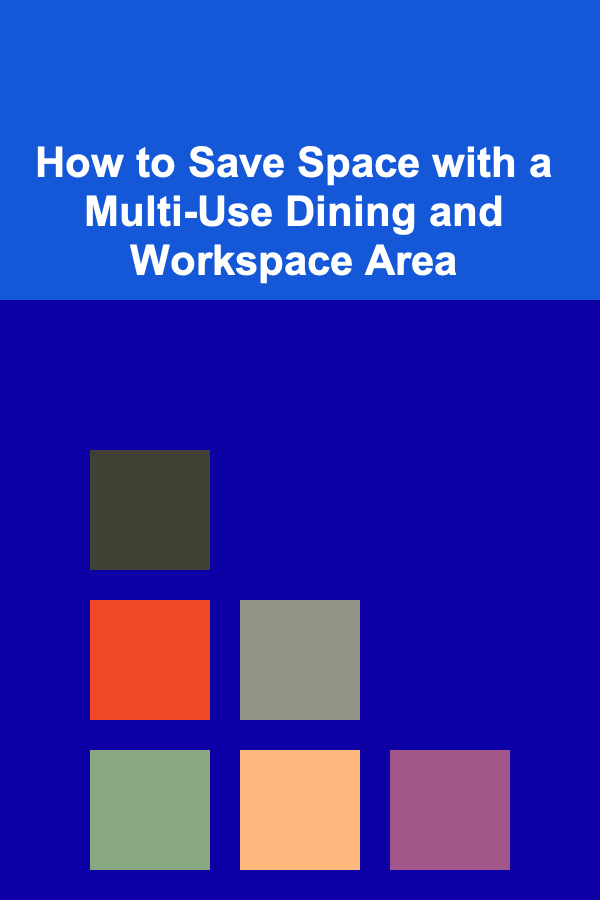
How to Save Space with a Multi-Use Dining and Workspace Area
ebook include PDF & Audio bundle (Micro Guide)
$12.99$9.99
Limited Time Offer! Order within the next:

In today's modern living environments, particularly in studio apartments or small homes, space is at a premium. Balancing functionality and comfort can be a challenge when you have limited square footage. One of the best ways to maximize space is by creating a multi-use area that serves both as a dining and workspace. This approach not only saves space but also creates a versatile area that can serve multiple purposes, from enjoying meals to working from home, without compromising on style or comfort.
This article explores how to design and utilize a multi-use dining and workspace area effectively, using space-saving techniques, clever furniture solutions, and creative layout ideas. It discusses the importance of combining practicality with aesthetics to make the most out of your living space, offering practical advice on everything from furniture selection to organizational tips.
Why a Multi-Use Dining and Workspace Area Makes Sense
Before diving into the details of how to create a multi-use dining and workspace area, it's important to understand why it's a great solution for modern living. Here are some key reasons why merging these two areas can be beneficial:
- Space Efficiency: In small living spaces, every square foot counts. Combining the dining and workspace functions eliminates the need for separate rooms, freeing up valuable space for other uses.
- Cost-Effective: Furniture can be expensive, especially when you need to buy separate pieces for dining and working. A multi-functional setup allows you to purchase fewer, more versatile pieces, which ultimately saves money.
- Convenience: With a multi-use dining and workspace area, you have everything you need in one place. Whether you're having a meal, working on a project, or holding a video conference, you don't have to move between different spaces. This increases overall efficiency in daily tasks.
- Flexibility: A flexible space allows you to easily adapt to different activities. You can move things around to host a dinner party or set it up for focused work, depending on the need at hand.
- Minimalist Aesthetic: Many people today prefer minimalist, clutter-free living spaces. A multi-use area, properly designed, reduces the need for extra furniture, contributing to a more streamlined, spacious look and feel.
Design Principles for a Multi-Use Dining and Workspace Area
Designing a space that serves both dining and workspace functions requires careful planning. It's important to consider not only the layout but also the type of furniture, storage, and lighting to ensure the space remains functional and aesthetically pleasing. Here are some key design principles to guide you in creating your multi-use dining and workspace area:
1. Choose the Right Furniture Pieces
The furniture you choose will have the greatest impact on how well your multi-use area functions. In a small space, every piece needs to serve more than one purpose. Here are some furniture ideas that can help achieve this:
Convertible Dining Table and Desk
A key piece of furniture in a multi-use space is the dining table. Look for a table that can double as a desk when needed. This could be a dining table with adjustable heights, where you can raise or lower the table depending on whether you're eating or working. Some tables come with built-in storage, providing a place to stash office supplies when you're not using them.
Folding Tables
Folding tables are ideal for small spaces as they can be folded up and stored away when not in use. You can set it up for dining and then fold it away to make room for work activities. A folding desk or table can be a game-changer, especially if you only need a workspace for part of the day.
Stackable or Nesting Chairs
Instead of using bulky chairs that take up too much space, consider stackable or nesting chairs that can be neatly stored when not in use. These chairs can be pulled out for meals and tucked away when you're working, maximizing space efficiency.
Storage Solutions in Furniture
Integrated storage is another must-have for a multi-use area. Look for dining tables, desks, or sideboards that offer storage drawers or cabinets. These can house office supplies, documents, or kitchen essentials, keeping everything organized and accessible.
Lounge Chair with Built-in Work Features
If space allows, a lounge chair with built-in work features like a fold-out desk or tray is a great addition. This can serve as a relaxation area when you're not working, but also transform into a work nook with minimal effort.
2. Create Clear Zones Within the Space
Even though the dining and workspace will coexist in the same room, creating clear visual or functional boundaries between the two areas will enhance both productivity and relaxation. Here are some ways to define the zones:
Use Rugs to Define Areas
Placing a rug under the dining table and another under the desk or work area can help visually separate the two spaces. Choose different textures or colors to create distinction, but make sure they complement each other to maintain a cohesive design.
Furniture as Dividers
Furniture can also help define the workspace. For example, a bookshelf or a sideboard can serve as a room divider between the dining and working areas. This creates a sense of separation without physically closing off the space.
Lighting Zones
Lighting plays a crucial role in defining zones within a multi-use space. Consider using a pendant light over the dining area and a task lamp or desk light in the workspace. The different lighting setups can help establish a functional atmosphere in each area.
3. Optimizing Storage for Both Dining and Work Needs
One of the challenges of a multi-use space is making sure you have enough storage for both dining and workspace items. A lack of storage can quickly turn a well-designed area into a cluttered, chaotic mess. Here are some smart storage solutions:
Wall-Mounted Shelves
Install shelves on the walls to store both work-related items (like books, files, or electronics) and dining items (such as glassware, plates, or napkins). Wall-mounted shelves keep items off the floor, creating more room for movement.
Under-Table Storage
Consider adding storage options under your table. For instance, a dining table with drawers underneath can be used to store office supplies. Alternatively, a storage unit or cabinet placed under a desk can hold extra office items or kitchen supplies.
Overhead Cabinets
If your ceiling height allows, consider adding overhead cabinets or floating shelves above your desk or dining table. These are excellent places for storing items you don't need every day but want to keep accessible.
Multi-Purpose Storage Solutions
For small apartments, storage pieces that combine multiple functions are ideal. Look for ottomans with hidden compartments, benches with storage inside, or coffee tables that open up to reveal extra space for books, papers, or dining supplies.
4. Maximize Natural Light and Ventilation
Natural light is a key element in making a space feel more open and inviting. Maximizing natural light in a multi-use dining and workspace area can improve productivity and make the space feel less confined.
Use Light Window Treatments
Opt for light, translucent curtains or shades that allow natural light to flow in. Avoid heavy curtains that can block light and make the space feel darker. If privacy is an issue, consider blinds that can be easily adjusted.
Use Mirrors to Reflect Light
Mirrors can also help maximize the perception of space and light. Place mirrors on walls opposite windows or near the work area to reflect light into the room and make the space appear larger and more open.
Keep Windows Unobstructed
Try to avoid placing furniture directly in front of windows, as this can block light and make the space feel cramped. If you have to place furniture near windows, consider low-profile options that allow light to pass through.
5. Incorporate Flexibility Into the Design
Flexibility is one of the most important elements of a multi-use space. Since the area will be used for multiple functions, you want to ensure it can easily be adapted for different tasks. Here are some ways to introduce flexibility into your space:
Adjustable Furniture
Look for furniture that can be adjusted to suit different needs. A height-adjustable table is perfect for switching between a dining table and a work desk. Adjustable chairs, too, can provide comfort for both dining and working.
Portable Furniture
Consider using portable furniture that can be moved around based on your needs. For example, mobile file cabinets or movable carts can be easily shifted to different areas. This can be especially helpful when you need more space for entertaining guests or hosting a meeting.
Flexible Layouts
Avoid permanent fixtures or arrangements that make it difficult to change the layout. If you need to move things around for an event, the space should accommodate that. Use lightweight furniture that's easy to rearrange, and avoid heavy or bulky pieces.
6. Maintain a Clean and Clutter-Free Space
A multi-use space has the potential to get cluttered quickly, especially if items from both the dining and workspace are not properly organized. Keeping your area clean and organized is crucial to maintaining functionality and comfort.
Daily Tidying
Make it a habit to clean up the dining and workspace areas daily. Put away any office supplies, dishes, or paperwork to prevent the space from becoming chaotic.
Use Organizers and Bins
Use organizers for both work and dining items. Drawer dividers, file organizers, or small bins can help keep everything in its place. When items are neatly stored, it's easier to transition between activities.
Go Paperless
If possible, go digital for work-related tasks. This reduces the amount of physical clutter in your workspace. Similarly, consider using electronic meal planning or grocery lists to cut down on the number of papers you keep in the kitchen area.
Conclusion
Designing a multi-use dining and workspace area requires creativity and planning, but the benefits are well worth the effort. By choosing the right furniture, optimizing storage, and using clever design strategies, you can create a functional and comfortable space that serves both as a dining area and a productive workspace. With thoughtful layout choices and smart storage solutions, you can make the most of your available space, no matter how small it is. By embracing versatility and flexibility, you can create a dynamic, efficient environment that adapts to your lifestyle and needs.
Reading More From Our Other Websites
- [Home Budget 101] How to Plan Affordable Home Improvement Projects That Add Value
- [Personal Investment 101] What is a Hedge Fund and Should You Invest in One?
- [Personal Financial Planning 101] How to Create a Personalized Financial Plan for Your Future
- [Organization Tip 101] How to Prioritize Your Tasks for Maximum Efficiency
- [Home Pet Care 101] How to Start DIY Pet Grooming for Beginners: A Step-by-Step Guide
- [Stamp Making Tip 101] Troubleshooting Tips: Getting Flawless Cuts and Clean Edges on Your Cricut Stamps
- [Home Budget Decorating 101] How to Maximize Space and Style with Budget Furniture
- [Organization Tip 101] How to Create a DIY Project Portfolio to Showcase Your Work
- [Home Staging 101] How to Stage Your Home for a Successful Open House Event
- [Home Renovating 101] How to Update Your Bathroom with Simple Renovations

How to Create a Checklist for Providing Employee References After Offboarding
Read More
How to Set Up an Ideal Pet Play Area at Home
Read More
How to Use Portrait Photography to Make Money
Read More
How to Use Scarcity and Urgency to Boost Conversions in Dropshipping
Read More
Step-by-Step Guide to Making DIY Pet Toys and Accessories Your Pet Will Enjoy
Read MoreHow to Integrate Your Credit Card Fee Tracker with Your Budget
Read MoreOther Products

How to Create a Checklist for Providing Employee References After Offboarding
Read More
How to Set Up an Ideal Pet Play Area at Home
Read More
How to Use Portrait Photography to Make Money
Read More
How to Use Scarcity and Urgency to Boost Conversions in Dropshipping
Read More